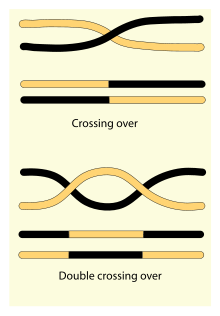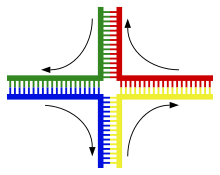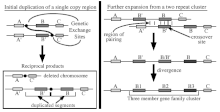Chromosomal crossover
In genetics, crossing-over is the process or result of a mutual exchange of corresponding segments of two homologous chromosomes (and thus the exchange of genes) in eukaryotes during the division of the germ cells.
This takes place quite frequently between paternal and maternal chromatids during meiosis (maturation division) and leads to new combinations of genetic information. Here, after strand breaks of the DNA molecules in so-called recombination nodes, mutual pairings of complementary single strands occur, whereby a crosswise overlapping also occurs. The microscopically visible result is a chiasm.
Crossing-over occurs when the cell nucleus divides during the prophase of meiosis I. This is not a case of faulty DNA repair. This is not a case of faulty DNA repair, but a process whose course is facilitated in a well-organized manner in the cell nucleus by structures formed for this purpose - the synaptonemal complex. During the first meiotic division in the zygotene of the prophase, the chromatids of a homologous chromosome pair are arranged in parallel, which enables a crossing-over between sections of non-sister chromatids that correspond to each other according to gene loci in the subsequent stage, the pachytene. This allows the exchange of parts between maternal and paternal chromosomes, which gives rise to new combinations (intrachromosomal recombination). In the following stage, the chromosomes detach from each other again, and previously occurred crossovers now also become visible as chiasmata under the light microscope in the diplotene.
In addition, in the following 2nd meiotic division (meiosis II), new combinations (interchromosomal recombination) arise through the new distribution of the parental chromatids as a whole in the simple chromosome set of the gametes.
The term "crossing-over" is not synonymous with "cross-breeding" as it is used in animal and plant breeding for the mating of individuals with different characteristics.

Schematic representation of a simple crossover and a double crossover
Expiration
Before meiosis, a normal duplication of the DNA occurs, so that all chromosomes are present with two chromatids. During meiosis, in prophase I, the two homologous chromosomes, i.e. the corresponding maternal and paternal chromosomes, attach to each other: The synaptonemal complex forms between them. The phase of attachment is called zygotene, the subsequent phase of pairing is called pachytene. The resulting structure is called bivalent (because there are two chromosomes) or tetrad (because there are four chromatids).
In some eukaryotes, the formation of the synaptonemal complex is only possible if recombination has already begun; in others, it can be formed without recombination having begun. However, the recombination process is always completed within the synaptonemal complex.
The breaks in the chromosomes are put together "crosswise" (crossing over). Therefore, whole chromosome regions are exchanged between two chromosomes. The DNA single strands are separated and so-called Holliday structures are formed.
As meiosis progresses, the newly combined homologous two-chromatid chromosomes shorten and diverge towards the cell poles as they migrate there along the spindle apparatus. However, if crossing-over has occurred, the chromatids remain slightly longer attached to each other at the sites of the still-fused region, which can be observed in the light microscope as a chiasma - a figure similar to the Greek chi "χ". Mosaic chromatids are formed, which contain both paternal and maternal genetic material.
Crossing-over is the prerequisite for intrachromosomal recombination and is one of the reasons why new trait combinations arise in sexually reproducing organisms.

Schematic representation of a Holliday structure

Schematic representation of genetic recombination by crossing-over in meiosis
Inequivalent crossing-over
If, during tetrad formation, two very similar but not homologous sequences are located next to each other - for example in the case of paralogous genes or transposons or satellite DNA - a crossing-over can occur, as a result of which sections are exchanged that do not correspond to each other: non-homologous or inequivalent crossover. After such an unequal exchange, corresponding parts are missing on one strand (deletion), which are represented twice on the other strand (insertion or duplication).
Inequivalent crossing-over can occur in paired chromatids during meiosis, occasionally also in asexual reproduction with mitotic nuclear divisions. On the one hand, inadequate crossover events are accidents; both deletions and insertions can lead to diseases, such as Huntington's chorea. On the other hand, cases of inaequal crossover with gene duplication represent a significant source for the evolution of gene families.
See also XX male and testis-determining factor: crossover of X and Y chromosomes.

Inequivalent crossing-over leads to unequal exchange between two chromatids: a portion is lost on one (deletion) and added on the other (insertion).
Questions and Answers
Q: What is crossing over?
A: Crossing over, also known as recombination, is the exchange of chromosome segments between non-sister chromatids that occur during meiosis.
Q: When does crossing over occur?
A: Crossing over occurs during meiosis.
Q: What is the effect of crossing over?
A: The effect of crossing over is to shuffle the alleles on parental chromosomes, which results in the gametes carrying different combinations of genes from either parent, and ultimately increases the variety of phenotypes in a population.
Q: What are chiasma?
A: Chiasma, also known as chiasmata, are visible crossovers that occur during crossing over, and they are Greek for a cross.
Q: Who suggested what chiasmata meant?
A: F.A. Janssens was the first to suggest what chiasmata meant.
Q: What is the main result of sexual reproduction compared to non-sexual modes of reproduction?
A: The main result of sexual reproduction compared to non-sexual modes of reproduction is the spread of variation through a population.
Q: What is the main advantage to parents in sexual reproduction?
A: The main advantage to the parents in sexual reproduction is the greater variety in their offspring, which increases the chances that some offspring will survive and reproduce.
Search within the encyclopedia